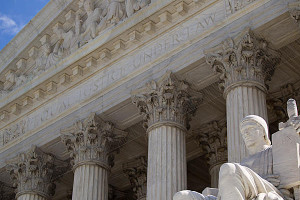by Debbie Haskins
In a landmark ruling issued on June 26, 2015, the United States Supreme Court ruled in Obergefell v. Hodges (pronounced “OH-ber-guh-fell”) that the right to marry is a fundamental right under the U.S. Constitution. In a 5-4 decision, written by Justice Anthony Kennedy, the Court held that:
- States cannot ban same-sex marriages and are required, upon request, to issue a marriage license to two people of the same sex; and
- States must recognize a marriage between two people of the same sex if the marriage was lawfully licensed and performed in another state.
Justice Kennedy based the majority opinion on four principles:
- The right to personal choice regarding marriage is inherent in the concept of individual autonomy;
- Same-sex couples have the same right as opposite-sex couples to enjoy intimate association;
- Marriage safeguards children and families, and the right to marry cannot be conditioned on the capacity or commitment to procreate;
- Marriage is a keystone of the nation’s social order from which no one should be excluded.
 Having found marriage to be a fundamental right, the Court next considered whether the challenged law unconstitutionally infringes on this right. The Court concluded that state laws preventing same-sex marriage are unjustified infringements on the fundamental right to marry under the due process and equal protection clauses of the 14th amendment to the U.S. Constitution.
Having found marriage to be a fundamental right, the Court next considered whether the challenged law unconstitutionally infringes on this right. The Court concluded that state laws preventing same-sex marriage are unjustified infringements on the fundamental right to marry under the due process and equal protection clauses of the 14th amendment to the U.S. Constitution.
In its opinion, the Court reviewed the history of marriage, noting that “after years of litigation, legislation, referenda, and the discussions that attended these public acts, the States are now divided on the issue of same-sex marriage.” The majority rejected the dissent’s argument that sufficient debate had not occurred in the country to make this decision at this time. Justice Kennedy wrote, “Individuals need not await legislative action before asserting a fundamental right.”
As a result of this decision, every state statute or state constitutional provision that bans same sex-marriage is now invalid.
The Rise and Fall of DOMA Laws
As Justice Kennedy noted, the public debate about same-sex marriage laws has been on-going in this country for the last two decades. In 1993, the Hawaii Supreme Court ruled that a law denying same-sex couples the right to marry violated the state’s constitutional equal protection guarantees unless the state could show a “compelling reason” for this discrimination. After the Hawaii decision raised the possibility that states would start recognizing same-sex marriage, several state legislatures adopted statutes or amended their constitutions to define marriage as a relationship that could only exist between a man and a woman. These laws are referred to as “Defense of Marriage Acts” or “DOMA.” Congress enacted a federal DOMA law in 1996, which limited the availability of over 1000 federal benefits to only those marriages that consist of a relationship between one man and one woman as husband and wife. According to the National Conference of State Legislatures, by the end of 2000, 40 states had either adopted a DOMA-type statute or constitutional provision or both. Colorado adopted its DOMA statute in 2000, and Colorado voters approved a DOMA constitutional provision in 2006.
However, in the last ten years, opinions about same-sex marriage have been changing. Eleven states and the District of Columbia have now enacted legislation authorizing same-sex marriage. On June 26, 2013, the U.S. Supreme Court struck down the federal DOMA law in U.S. v. Windsor holding that the restrictions on federal benefits violated equal protection and due process for same-sex couples who were legally married in a state that  recognized same-sex marriages. In that decision, also written by Justice Kennedy, the Court emphasized that states have the power to define marriage. On the same day, the Court also held that the proponents of Proposition 8, a voter-approved ban on same-sex marriage in California, did not have the legal right to defend the measure in court. Although based on the technical issue of standing, the decision in Hollingsworth v. Perry made same-sex marriages legal in California.
recognized same-sex marriages. In that decision, also written by Justice Kennedy, the Court emphasized that states have the power to define marriage. On the same day, the Court also held that the proponents of Proposition 8, a voter-approved ban on same-sex marriage in California, did not have the legal right to defend the measure in court. Although based on the technical issue of standing, the decision in Hollingsworth v. Perry made same-sex marriages legal in California.
After these decisions, same-sex marriage bans toppled in state and federal courts across the country. Federal appeals courts in the Fourth, Seventh, Ninth, and Tenth Circuits all ruled that state bans on same-sex marriage are unconstitutional. The U.S. Supreme Court refused to hear appeals in these cases on October 6, 2014, causing the Colorado Attorney General to declare that all legal barriers to same sex marriages in Colorado, which is in the Tenth Circuit, were removed. As a result, same-sex marriages became legal in Colorado on October 7, 2014.
Meanwhile, the Sixth Circuit Court of Appeals upheld DOMA laws from Kentucky, Michigan, Ohio, and Tennessee, creating a split among the circuits in the country. Often when there is a circuit split, the U.S. Supreme Court will grant certiorari to resolve the matter, as it did in Obergefell.
By the time the U.S. Supreme Court heard the Obergefell case from the Sixth Circuit, same-sex marriage was legal in the United States in 37 states either because of state or federal court decisions or because of state statutes authorizing same-sex marriage. As a result of the Obergefell decision, same-sex marriage is now legal in the entire country.

